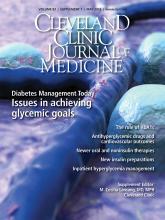ABSTRACT
Hemoglobin A1c (HbA1c) is a widely used tool for diagnosing, screening, and managing patients with diabetes; however, proper application and interpretation of the HbA1c test is crucial to master for accurate assessment of patients. It also has become the standard test in population-based studies for evaluating the relationship between glycemic control and cardiovascular risk. Result from large clinical trials support the modern perspective that the HbA1c target should be personalized according to the risks and benefits of glycemic control. This likely is most important in patients with diabetes and elevated cardiovascular risk in whom achieving low HbA1c levels early in the natural history may be the most beneficial.
Footnotes
Both authors reported that they had no financial interests or relationships that posed a potential conflict of interest with this article.
- Copyright © 2016 The Cleveland Clinic Foundation. All Rights Reserved.
- Courtney Nagel Sandler, MD⇑
- Correspondence:
Courtney Nagel Sandler, MD, Brigham and Women’s Hospital, Division of Endocrinology, Diabetes, and Hypertension, 221 Longwood Avenue, RFB-2, Boston, MA 02115; cnsandler{at}partners.org
ABSTRACT
Hemoglobin A1c (HbA1c) is a widely used tool for diagnosing, screening, and managing patients with diabetes; however, proper application and interpretation of the HbA1c test is crucial to master for accurate assessment of patients. It also has become the standard test in population-based studies for evaluating the relationship between glycemic control and cardiovascular risk. Result from large clinical trials support the modern perspective that the HbA1c target should be personalized according to the risks and benefits of glycemic control. This likely is most important in patients with diabetes and elevated cardiovascular risk in whom achieving low HbA1c levels early in the natural history may be the most beneficial.
Footnotes
Both authors reported that they had no financial interests or relationships that posed a potential conflict of interest with this article.
- Copyright © 2016 The Cleveland Clinic Foundation. All Rights Reserved.






